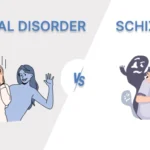- April 25, 2025

Bipolar disorder is a mental health condition that involves alternate periods of mania, hypomania, and depression. It can affect how a person thinks, feels, and functions in their everyday routine. Bipolar disorder in women is just as common as in men, but bipolar disorder symptoms in women can look different.
Recognizing these symptoms early can make a world of difference. In this piece, we will explore how bipolar disorder affects women, physical symptoms to notice, and how to manage it with compassion and care. Let’s dive in!
What is Bipolar Disorder?
Bipolar disorder is a mental health condition marked by extreme mood swings, episodes ranging from mania (highs) to depression (lows). These mood shifts aren’t just momentary; they can last for days, weeks, or even months, deeply impacting relationships, productivity, and overall emotional well-being.
Types of Bipolar Disorder
There is no one-size-fits-all diagnosis for bipolar disorder. It comes with distinct types, each with its symptoms and patterns. Here’s a look at different types of bipolar disorder:
Bipolar I Disorder
There is no one-size-fits-all diagnosis for bipolar disorder. It comes with distinct types, each with its symptoms and patterns. Here’s a look at different types of bipolar disorder:
Bipolar II Disorder
Bipolar II disorder shows a pattern of depressive episodes and hypomanic episodes (less severe than full mania). Its symptoms are often mistaken for mood swings.
Cyclothymic Disorder (Cyclothymia)
Chronic fluctuating moods over two years or more, without meeting full criteria for mania or depression.
Cyclothymic disorder shows milder symptoms of depression and hypomania. Most women with bipolar I and bipolar II disorder experience periods of relative stability in between manic or depressive episodes. At the same time, women with cyclothymic disorder have episodes every two months at most.
How Bipolar Disorder Can Be Different For Females?
While bipolar disorder affects both men and women, symptoms of bipolar disorder in women often follow unique patterns. Women are more likely to experience symptoms that are often identical to general mood swing signs. Episodes of mania, depression, rapid cycling, breathing issues, racing thoughts, and others can occur at any stage.
Hormonal changes during pregnancy, menopause, premenopause, and PMS can also impact the course and severity of bipolar symptoms. This doesn’t mean bipolar disorder is worse in women, but it does suggest the need for personalized treatment plans that consider hormonal and psychosocial factors.
Bipolar Disorder Symptoms in Females
Recognizing the signs of bipolar symptoms early is key to getting support. Common bipolar disorder symptoms in females include:
Emotional & Behavioral Signs
- Extreme mood swings, elevated irritability
- Hopelessness or tearful during depression
- Impulsivity, risky behavior
- Changes in sleep, insomnia during mania
- Oversleeping in depression
- Low energy, lack of interest, or emotional withdrawal
- Difficulty concentrating or making decisions
20 Surprising Physical Symptoms of Bipolar Disorder
In addition to emotional signs, many women experience physical symptoms of bipolar disorder. Due to the lack of studies in the area, these symptoms often go overlooked:
- Chronic fatigue
- Muscle tension or body aches
- Headaches
- Gastrointestinal issues
- Weight fluctuations
- Menstrual irregularities
- Shortness of breath
- Sweating episodes
- Dizziness
- Appetite changes
- Blurry vision during manic episodes
- Sleep paralysis
- Chest pain or heart palpitations
- Numbness or tingling in different body parts
- Restlessness or hyperactivity
- Hormonal acne flares
- Temperature sensitivity
- Increased pain sensitivity
- Skin rashes under stress
- Irregular heartbeat
These symptoms of bipolar disorder often mimic other health issues, leading to misdiagnosis. That’s why it’s essential to consult with a professional for suitable treatment when assessing bipolar disorder in women.
Management and Treatment of Bipolar Disorder in Females
Treatment plans for bipolar disorder address brain changes, as emerging research links bipolar disorder to structural and functional brain differences. It addresses and treats the brain areas regulating emotion and cognition. Although there’s no definitive cure for bipolar disorder, it is highly manageable with the right approach:
Medication:
Mood stabilizers, antipsychotics, and antidepressants (with prescription)
Psychotherapy:
Cognitive Behavioral Therapy (CBT), psychoeducation, and family therapy
Lifestyle changes:
Regular sleep, exercise, mindful nutrition, and stress reduction
Support systems:
Connect with peer groups and mental health communities, which offer invaluable encouragement
When to Seek Professional Help?
Suppose emotional or physical symptoms are starting to interfere with your daily life, workplace, relationships, or you notice patterns of highs and lows that seem intense or cyclical. In that case, it’s time to consult a certified professional. Early intervention can reduce the risk of severe episodes or reaching the end stage of bipolar disorder, when untreated symptoms cause significant functional decline or hospitalization.
Living with Bipolar Disorder as a Woman?
Living with bipolar disorder isn’t a limitation; it’s a journey of self-awareness and strength. With proper care, many women manage their condition while leading fulfilling lives, balancing careers, relationships, and personal growth.
It’s helpful to understand how a person with bipolar disorder thinks; their perspective often includes intense emotions, rapid thoughts, and shifting confidence levels. Compassion, for oneself and from others, is critical.
Conclusion
Understanding the bipolar disorder symptoms in females is the first step toward healing. Understanding emotional, behavioral, and physical signs helps with crafting a personalized treatment plan. With proper treatment, support, and awareness, women living with bipolar disorder can reclaim control and live balanced lives. Whether you’re noticing signs in yourself or supporting a loved one, remember to address the symptoms and seek timely treatment.
Contact Windermere Medical Group now and let’s work together on your path to wellness.
FAQs
01. Is bipolar disorder curable?
No, but it is manageable with lifelong treatment. Many people live stable, happy lives with the right support.
02. How does a person with bipolar think?
They may experience racing thoughts, depressive thoughts, mood-driven decisions, and a heightened or blunted perception of reality.
03. What are bipolar facial features?
While not diagnostic, some individuals report noticeable changes in facial expressions, which are more intense during mood episodes; however, these are not medically defined traits.
04. What is end-stage bipolar disorder?
It refers to advanced stages of the condition where untreated symptoms cause chronic functional impairment, frequent hospitalizations, or cognitive decline.
05. What causes bipolar disorder?
A combination of genetics, brain structure & function, and environmental stressors can cause bipolar disorder. Untreated symptoms and family history increase risk.
06. Which type of bipolar disorder is more common in women than men?
Bipolar II is more commonly diagnosed in women, often due to longer depressive episodes and hypomanic patterns.
**
The material on this site is for informational purposes only and DOES NOT CONSTITUTE THE PROVIDING OF MEDICAL ADVICE, and is not intended to be a substitute for independent professional medical judgment, advice, diagnosis, or treatment. Always seek the advice of your physician or other qualified healthcare provider with any questions or concerns you may have regarding your health.
Recent Post






